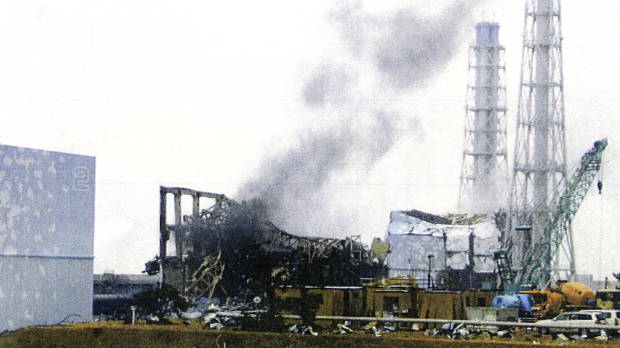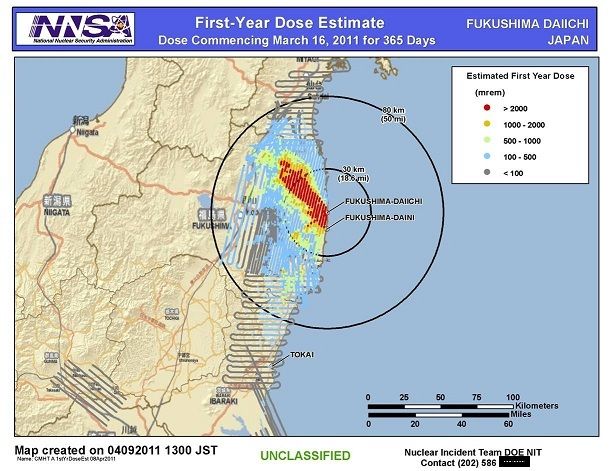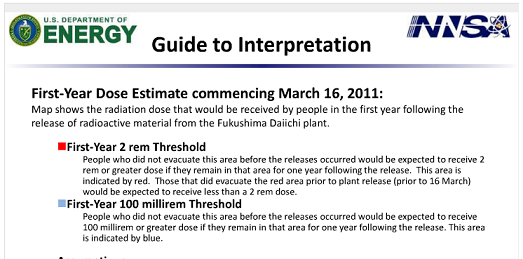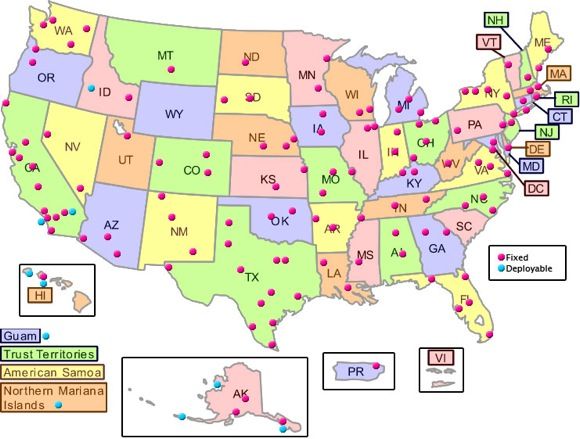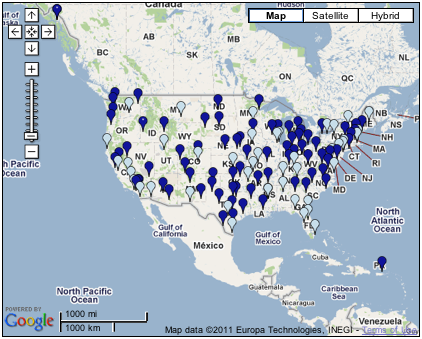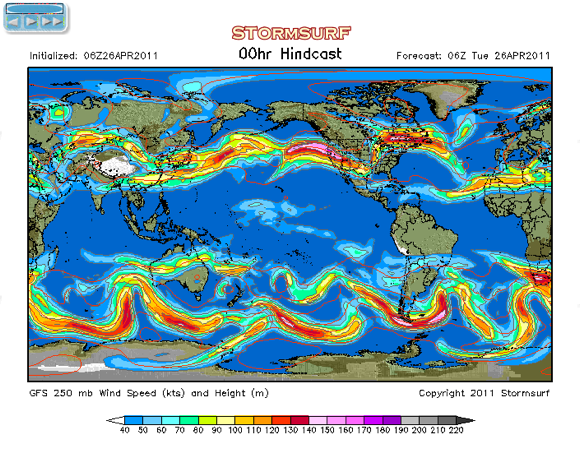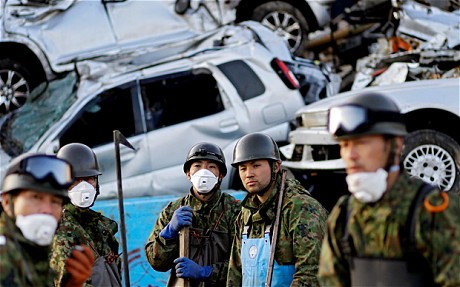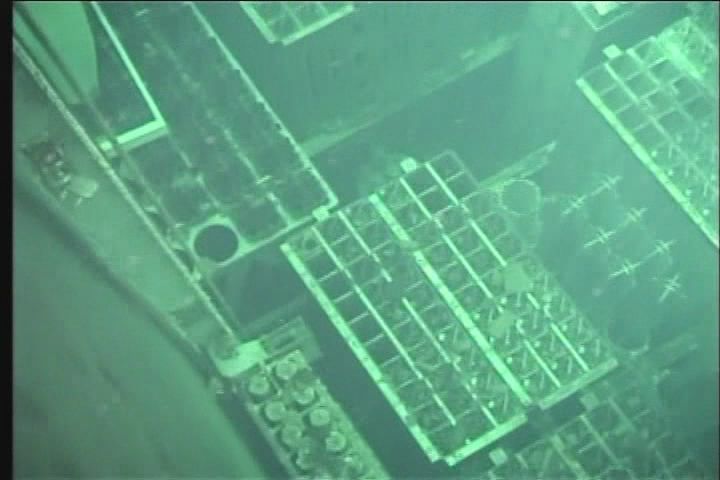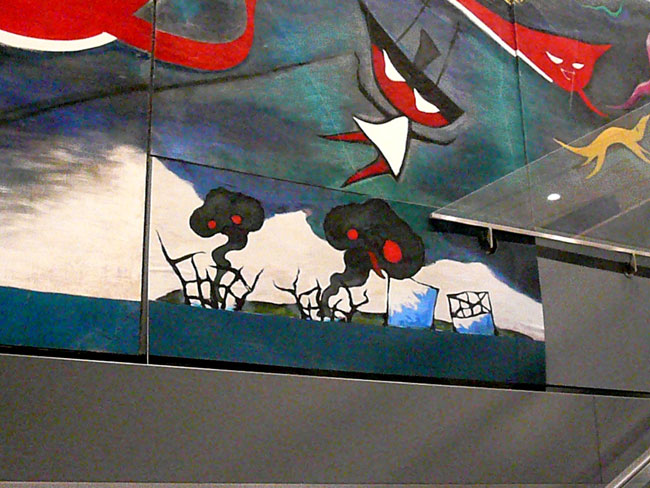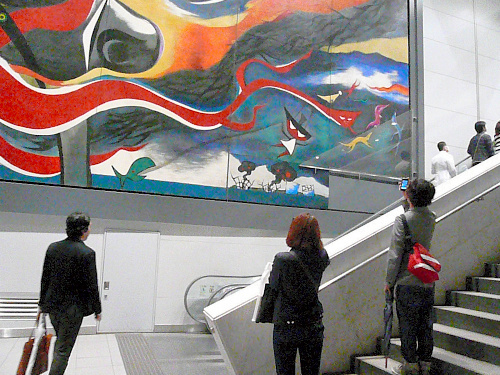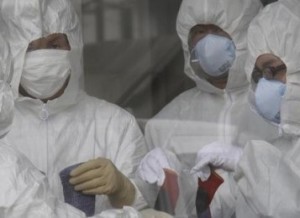|
|
|
|
April 25 to May 10
|
|
|
April 19, 2011 The spin machine at TEPCO, continues to state that radiation levels
in the reactors are getting lower, in fact human workers can now go in
and do some work...unfortunately, these pack bots don't have the capability,
like humans, to lie.
I'm placing my bets on the bots... uh huh....
PackBots originally designed to help U.S. troops are sent to Japan
to survey damage to Fukushima nuclear plants. They discovered high radiation
levels during the first entry into the plant devastated by the March 11
earthquake and tsunami.
[PDF Version] A pair of 60-pound military robots originally designed for such tasks
as disarming bombs and combat zone surveillance have entered reactor buildings
at the stricken Fukushima nuclear power plant in Sendai, Japan.
The PackBot robots, provided by iRobot, are already reporting that the
radiation levels in the power plants are too high for humans to spend any
significant time in the plants, according to a New York Times report. The
robots, outfitted with a set of sensors originally designed for hazardous
materials incidents, have entered reactors 1 and 3 of the plant, which
were damaged during the catastrophic March 11, 2011, earthquake and tsunami.
The PackBot robots, provided by iRobot, are already reporting that the radiation levels in the power plants are too high for humans to spend any significant time in the plants, according to a New York Times report. The robots, outfitted with a set of sensors originally designed for hazardous materials incidents, have entered reactors 1 and 3 of the plant, which were damaged during the catastrophic March 11, 2011, earthquake and tsunami. ~ Source From this article 4 18 2011 States TEPCO needs to get "creative" in order to do anything to follow the "plan". Radiation Poses Barrier to Repair Work at Plant
- By HIROKO TABUCHI
TOKYO — Robots deployed inside two reactors at the Japanese nuclear
plant overrun by last month’s devastating tsunami have detected radiation
levels too high for workers to enter, posing immediate challenges for a
new plan to bring the ravaged complex under control by year’s end.
“It is a harsh environment for humans to work in,” said Hidehiko
Nishiyama, deputy director general at the Nuclear and Industrial Safety
Agency. He said the levels would require the plant’s operator, the Tokyo Electric
Power Company, to be “creative” in bringing the plant to a stable state
known as a cold shutdown within six to nine months, as the company laid
out in a timetable on Sunday ~ Source Des |
|
|
April 19, 2011 One of the good things to come from situation at Fukushima is the renewed attention to Chernobyl. Governments from around the world today pledged $785m (€550m)
to seal the stricken nuclear reactor at Chernobyl within a 20,000-tonne
steel shield that would be large enough to enclose St Paul's Cathedral
in London. The huge arch is designed to prevent any further radiation from
escaping for 100 years. World governments, which had already raised more than €1.1bn
in international funding for the shelter, as well as for a permanent nuclear
fuel store for other reactors on the Chernobyl site, said that the current
crisis in at the Fukushima plant in Japan persuaded them to respond to
the appeal by Ukraine, which estimates the accident has so far cost the
nation more than $12bn. ~ The
Guardian
I tended to think of the Chernobyl disaster as being in the past,
but the reality is that the plant still poses considerable danger to this
day. "There is almost 200 tons of radioactive material still inside the
old sarcophagus," said Dodd, who has worked here off and on since 1995.
"And the existing sarcophagus was built in six months in 1986 under, I
should say, fairly heroic conditions and it had a design life of 10 years
- that’s almost 25 years ago." ~ Voice
of America
This news is a reminder that "cleaning up" after a nuclear disaster is a very, very, very long process - something we will likely to have to leave to our children. The promotional video on the Guardian site demonstrates the HUGE scale of the work required for decontamination. Hopefully some of this will help the Japanese deal with Fukushima Originally posted by Destinyone Thank you TEPCO...saying "pellets" have melted.... sheesh, they make it sound like bb's decided to melt to a liquid state, all by their little own selves. Just because Edano says it...doesn't make it so. April 19, 2011 in Nation/World
“Even I had expected high radioactivity in those areas. I’m sure (plant operator Tokyo Electric Power Co.) and other experts have factored in those figures when they compiled the roadmap,” Chief Cabinet Secretary Yukio Edano said. Officials said Monday that radiation had spiked in a water tank in Unit
2 and contaminated water was discovered in other areas of the plant. They
also described in more detail the damage to fuel in three troubled reactors,
saying pellets had melted. ~ Source
Originally posted by makeitso The Situation in Japan (Updated 04/19/11)
Last month, the U.S. Department of Energy released data recorded from its Aerial Measuring System as well as ground detectors deployed along with its Consequence Management Response Teams. Today, the Department provided the following update on the information gathered by the AMS.
|
|
| April 19, 2011 Originally posted by Vitchilo Monday night, Tepco said it detected
high radioactivity coming from the spent fuel pool of the No. 2 unit, indicating
that either the fuel rods in the pool were damaged or steam containing
radioactive materials that rose from the reactor dissolved in the pool
water. Some 160,000 becquerels per cubic cm of cesium-134,
150,000 becquerels of cesium-137 and 4,100 becquerels of radioactive iodine-131
were detected in a water sample extracted from the storing pool on Saturday.
Radiation at No. 2 spent fuel pool 30,000,000 times above normal & 15,000 times more than troubled No. 4 pool Originally posted by makeitso Additional Info Press Release (Apr 18,2011) On the Result of Water Analysis in the Skimmer Surge Tank of Fukushima Daiichi Nuclear Power Station Unit 2 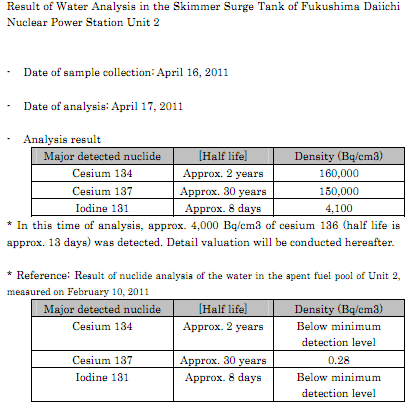 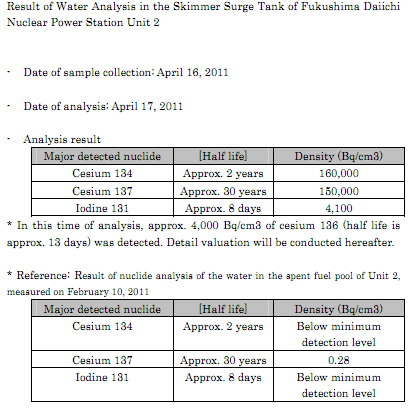
|
|
|
April 20, 2011 Yet another study gathering dust on TEPCO's bookshelves from just last year. Fukushima should have cracked open the book they have now become the poster child for. Nuke plant meltdown warning went unheeded Japanese nuclear power plant operators were totally unprepared for the potential long-term loss of power supply, a lifeline to help cool nuclear reactors, according to people with knowledge of the matter. Meanwhile, the Japan Nuclear Energy Safety Organization (JNES) released last fall a simulation in which a nuclear reactor would have a core meltdown and other consequences only 100 minutes after losing its cooling capabilities. The study shows that a meltdown began about one hour and 40 minutes after the water- pumping function stopped. About 3 hours and 40 minutes later, the pressure container broke down and about 6 hours and 50 minutes later the containment vessel also ruptured. At the Fukushima nuclear plant, the pressure within the containment vessel of the No. 1 reactor abnormally surged at 1:20 a.m. on March 12, about 8 hours and 40 minutes after the reactor's water-filling function failed. Radioactive steam was vented from the containment vessel and a hydrogen explosion occurred at 3:36 p.m. the same day. In the No. 3 reactor, the water injection function malfunctioned, prompting
the release of radioactive steam and triggering a hydrogen explosion shortly
after 11 a.m. on March 14. The reactor's cooling function equipped with
the reactor's pre-warning device was believed to have been still operative
for some time after the loss of its power source.
Source
More evidence they knew what was happening this entire time. And they are still getting away with it. So sad and so wrong. And it's not just TEPCO. Thanks all for the reading materials this evening. Very helpful. There has been so much discovery in this disaster recently, I'm still trying to wrap my head around exactly where this plant stands and what this carnage says about the social structures we have allowed to exist. It is so far beyond the cold shutdown verbage on Tepco's website....Where is truth and honor in our modern business model? :( Wait a minute... it's here. Where a virtual here can have more truth and honor and reality than a RW here, So grateful to all the beautiful minds on ATS. It gives some hope for tomorrow. Thank you so very much for sharing your thoughts and ideas and inklings. At least people have a place to come and follow along and find out what is really happening. A place to begin to fit the pieces together. A place to assemble and share and compare. I sleep better knowing the ATS night crew/day crew/afternoon crew you name it are on duty. There are people who care deeply about what we are doing to our world and why this is being allowed to happen. Thanks again. Everyone.
|
|
| April 20, 2011 Small amounts of radioactive iodine found in breast milk FUKUSHIMA, Japan, April 20, Kyodo A citizen's group concerned about the impact on mothers and babies of the radioactive leaks from a crippled nuclear power plant in Fukushima Prefecture said Wednesday that small amounts of radioactive iodine have been found in the breast milk of four women living east or northeast of Tokyo. Of the samples provided by the four women, the breast milk of the mother of an 8-month-old baby in Kashiwa, Chiba Prefecture, contained the highest level of 36.3 becquerels of radioactive iodine per kilogram, but no radioactive cesium was found, the group said. The Nuclear Safety Commission of Japan has not set safety levels for radioactive substances in breast milk, according to the Health, Labor and Welfare Ministry. But the reading was below the safety limit of 100 becquerels per kg for tap water consumption by infants under 1 year old. Agency admits 'melting' of N-fuelThe Yomiuri Shimbun The Nuclear and Industrial Safety Agency has reported to a Cabinet Office safety panel that nuclear fuel pellets in the Nos. 1 to 3 reactors at the quake-hit Fukushima power station are believed to have partially melted. The report was the first time the agency, an organ of the Economy, Trade and Industry Ministry, has acknowledged that nuclear fuel has melted at the Fukushima No. 1 nuclear plant. Hidehiko Nishiyama, a spokesman for the agency, told a press conference Monday about the agency's report to the Nuclear Safety Commission. The agency had previously only described the nuclear fuel as having been at least 3 percent "damaged." According to Nishiyama, damage to reactors can be described in three phases of increasing severity. In the first phase of initial damage to a reactor's core, the metallic casing surrounding the fuel pellets are damaged but the pellets remain intact. The second phase involves some melting of nuclear fuel. In the third phase, what is known as a meltdown, all the fuel pellets melt and accumulate at the bottom of the containment vessel. The agency said it now believes the fuel pallets have melted because of the high levels of radiation detected at the Nos. 2 and 3 reactors. Melting fuel pellets also likely led to a hydrogen explosion at the No. 1 reactor, Nishiyama said. Tokyo Electric Power Co., the operator of the crippled plant, has said the cores of the Nos. 1 to 3 reactors have been damaged by 25 percent to 70 percent. But the agency emphasized that these figures are only estimates. "We can't say for sure about how much has melted until the rods are actually taken out," Nishiyama said. The Yomiuri Shimbun |
|
|
April 20, 2011 Article date April 18 Fukushima Residents Seek Answers Amid Mixed Signals From Media, TEPCO and Government. Report from the Radiation Exclusion Zone
The government charges that the damage caused by earthquakes and by the nuclear accident are being magnified by irresponsible rumors, and the government must take action for the sake of the public good. The project team has begun to send “letters of request” to such organizations as telephone companies, internet providers, cable television stations, and others, demanding that they “take adequate measures based on the guidelines in response to illegal information. ”The measures include erasing any information from internet sites that the authorities deem harmful to public order and morality. ~ Asia Pacific Journal |
|
|
April 21, 2011 Originally posted by DancedWithWolves TEPCO's expendables begin to figure out they are being used, lied to and sacrificed. Workers at nuke plant complain about handling of radiation exposure data A 30-year-old emergency worker from a subcontractor said he had been told by an official of a primary contractor shortly before joining in restoration work at the troubled nuclear power plant in late March that, "The dose of radiation you are going to be exposed to this time will not be on your radiation exposure registration record. So, don't worry." In late March, the president of his company which specializes in checking pumps told him: "We were asked by our client to send someone just for three days. If the situation is really bad, you can come back in the middle of your work. I want you to go just for three days right away." The man then headed for the nuclear power plant. He did not know any details of what he was supposed to do there. But after arriving at the scene of the crisis, he was told to connect electric cables necessary to restore power to a spent nuclear fuel pool, which is out of his domain. "They seem to be desperate to attract any available workers to restore electric power no matter what," he said. He carried on with his job while receiving instructions from experienced
workers: "I took a long time to do the job because I had never done it
before, and I was unnecessarily exposed to radiation." At that time, dosimeters
were in short supply, with only one given to his group of six. His radiation exposure registration booklet was kept at a primary contractor he had worked for before the March 11 earthquake, and therefore he did not have it with him. "I haven't had it for a long time, and therefore I am not sure if the radiation I was exposed to this time was added on to my registration booklet," he said. There is no way of confirming it because the company has not been operating since the earthquake. Another worker said: "The way the registration booklets are handled varies from one subcontractor to another. Presumably, subcontractors may not put the latest date on the registration booklets in a bid to receive orders in the future. The company may be able to receive orders, but the people left holding the bag in the end are the workers," he said. I cannot begin to imagine what these workers are going through. Would this not be falsification of data and exposing worker's to untold radiation without detectors. There is no excuse for workers not having basic detectors. This is intentional. I have lost all faith in the safety provisions of nuclear plants and the industry that supports them. Safety is an illusion they have carefully crafted. What is going on at this plant? Are there any independent inspectors there? Anyone? Thankfully some media in Japan are getting this story out. Second story with further details about the radiation exposure cover-up: Nuke authorities vague about radiation exposure limits for emergency workers |
|
|
April 21, 2011 TY NoAngel, she does tell it like it is. Lack of info from Japan is making a few ripples... Retired nuclear engineer worried by lack of news from Japan
The recent silence from Japan about conditions at the Fukushima Daiichi nuclear facility that was damaged in the March 11 earthquake and tsunami has a local man wondering just how severely the facility has been damaged. The one thing he does know is that whatever is going on inside the reactors is very serious. “It’s been kind of quiet out of Japan. This is not good,” said Eddie Petrowsky, nuclear engineer, area farmer and former employee of the Morris, Ill., Dresden No. 2 Nuclear reactor. “They’ve got some major problems.” Petrowsky worked for two and half years as the lead nuclear engineer at the Morris facility, which is of the same type as the Fukushima facility, so he is familiar with its construction and operation. When the aircraft flew over the site and dropped boron on the facility they were trying to absorb the neutrons from the explosion. Boron rods absorb neutrons and are used to control the nuclear reaction. The more the rods are pushed into the reactor, the slower the reaction, the more they are pulled out, the greater the reaction. The use of boron also told Petrowsky that the plant was using
plutonium
in the reactor. Most countries are prohibited from using plutonium
because
it is easy to use it to make nuclear weapons ~ Source Des
|
|
| April 21, 2011 Originally posted by Destinyone Anger Greets Kan in Fukushima Trip
By TOKO SEKIGUCHI And MITSURU OBE ASIA NEWS
TOKYO—Japanese Prime Minister Naoto Kan came under renewed criticism Thursday as he visited the area around Japan's damaged Fukushima Daiichi nuclear complex and unveiled tightened limits on the plant's evacuation zone, as frustrations mount over the government's handling of the nuclear crisis. To my knowledge, they have not plugged the leak to date... Meanwhile, plant operator Tokyo Electric Power Co. released further details about the accidental release of highly radioactive water from the plant earlier this month, saying it totaled 520 tons and had concentrations of radioactive material of about 100 million times Japan's legal limit, underscoring the scramble to plug the leak. And still...evacuees ask for the bare basics...like food. "We don't think the government is making enough of an effort," said Shinichi Suzuki, deputy mayor of the town of Naraha, citing what he said was a lack of information about the crisis, as well as the fact that a nearly a quarter of his town's 8,000 residents are still in shelters. "Many people are still living in a gymnasium without any privacy, more
than a month after the evacuation," he said. "The government should have
built more temporary housing. Food is also a problem. There are many elderly
among the evacuees." ~ SOURCE Des Originally posted by Destinyone Found
this bit of info. If the scientist is accurate, it could be a boon to
aiding TEPCO in this mess of a crisis. Alas, the poor man is not making
progress in dealing with TPTB.
Chemist: I Can Clean Fukushima Water Faster
By Yoree Koh French nuclear engineering company Areva SA will lend its services to treat the pools of radioactive water at the troubled Fukushima Daiichi nuclear power plant, lifting a crucial obstacle hindering repair efforts. But a Japanese chemist claims he has developed a powder substance in less than a month that he says could decontaminate the toxic water 20 times faster than the French method, thereby significantly accelerating progress toward the ultimate goal of cold shutdown. Tomihisa Ohta, a professor at Kanazawa University’s graduate school of natural science and technology, says his white powder, made up of an assortment of natural minerals and chemicals, would essentially capture the radioactive materials from the contaminated water in a process that could treat 1,000 tons of water in an hour. Areva’s treatment system can remove radioactive material from 50 tons of water an hour. Mr. Ohta said he reached out to Fukushima Daiichi operator Tepco and the government about a week ago when he finished developing the radioactive bent powder. Discussions are ongoing, he said. Relevant Tepco and government officials couldn’t immediately be reached for comment. ~ SOURCE Des |
|
|
April 21, 2011 The link you posted seems to have gone down for some reason, but there are always backdoors. We thought that the original article was so good, we will post some more of it to add to your fine post. The Pratt Tribune. This article breaks it down in lay person's terms by a bona fide nuclear engineer and local farmer. We also like his smile and think that this person is a stand-up individual.
Smiling
Ed
When the earthquake and tsunami hit, Petrowsky watched with great interest how the facility would handle the crisis and control the threat of radiation contamination. The Japanese are getting close to a point where they may have to turn each of the damaged reactors into a sand and concrete sarcophagus similar to the sarcophagus at the Chernobyl Nuclear Power Plant in Ukraine following an explosion on April 26, 1986, Petrowsky said. The people working at the accident site have been exposed to a lot of radiation and Petrowsky said that survivability was probably slim and the workers would obviously have a lot of health issues. When the earthquake and tsunami hit the reactors went into shutdown or scram. Water is supposed to be pumped continuously to keep the reactors cool but both the outside power and backup power failed. It was never assumed that the plant would lose coolant but when all the power failed that is exactly what happened. Without those systems the critical coolant water that helps produce steam and keeps the reactor temperate at a safe level did not circulate and the reactors and the fuel pool began to heat up, Petrowsky said. “They were worried about the water level,” Petrowsky said. He wants to know why the Japanese didn’t bring in stand by generators. The country makes generators, American Navy vessels[/color] were in the area and had generators so why weren’t generators brought in? Petrowsky said. The loss of water caused dangerous heat to build up leading to hydrogen gas explosions that damaged three of the plant’s six reactors. Each of the nuclear reactors at the site has three containment vessels. The reactor is a containment vessel itself. Around the reactor is the primary containment vessel and around that is the secondary containment vessel, Petrowsky said. When the water failed the temperature inside the reactor rose and caused pressure to buildup inside the primary containment vessel. To relieve that pressure, hydrogen steam was released from the primary containment vessel into the secondary containment vessel. The release caused a buildup of hydrogen the rejoined with oxygen and the pressure was too great and it blew the roofs off the secondary containment vessels.That is what people saw exploding on television. So the primary containment vessels still held but inside the primary, without cooling water, damage continued and it is that damage plus the damage to the fuel pool[/color] that has Petrowsky wondering what the Japanese are going to do with the facility. And it wasn’t just the water in the reactors that was the problem. When the boron fuel rods used to control the nuclear reaction in the reactor have been used up they are still radioactive and will stay that way for thousands of years. Seems to me that the numbers for "concernable" radioactivity being bandied about by the MSM never mentioned thousands of years. Those rods are stored in a fuel pool that continuously covers the rods with recirculated water that keeps the temperature down and controls radiation. The fuel pool doesn’t have a containment building like the reactor but just a metal building. When the water failed, the rods got hot and caused a hydrogen
explosion that blew the top of the fuel pool building off[ releasing
radioactive steam, Petrowsky said. We are inviting Mr. Petrowsky to join us here. |
|
| April 21, 2011 Originally posted by makeitso I have been fairly ticked off lately.
Most of the sane blogs that I read to keep up on nuclear issues have been sadly lacking any meaningful dialog on Fukushima, and the ones that do have a dialog seem to poo-poo the problems there a bit too much for my taste, even though they fall on the moderately anti-nuclear side of the issues.To be fair though they are usually carry nuclear proliferation topics. Despite this I still keep checking them in. Today I am more more ticked off. One of the blogs posted a history lesson on problems with spent fuel storage at reactors. Its not about Fukushima specifically. Its about all reactors who use this type of storage for spent fuel. He told his story about finding specific problems with them, that we have seen come to fruition at Fukushima. He talks about specific problems, and what they knew would happen, and why it would happen if the spent fuel overheated. He lets us know how long the nuclear industry has been aware about the problems, how many people they knew would be radiated, how much it would cost them, how they decided to completely ignore the problems, and how he has been working for years trying to get changes made to at a minimum make them safer. He even wrote a book about it, and has now made the related portion available to the general public via the interwebs. So, oddly enough, now that one of them actually posted something relevant,
the content of the article is almost enough to make me wish they hadn't
posted it, because now...
I'M REALLY TICKED OFF
Do not read the blog post and this portion of his book if you
wish to continue your evening in blissful peace. November 1992
The design calculation for the reactor building ventilation system [..] amounted to 5.2 million BTUs per [..] The cooling system for the reactor building ventilation system was sized to accommodate this amount of heat removal [..] But the design heat load from irradiated fuel stored in the spent fuel pool was 12.6 million BTUs per hour[..] safety analyses assume the spent fuel pool cooling system will not be operating during a reactor accident. [..] but without cooling the spent fuel pool water would heat up, boil, and release heat into the reactor building air. A lot of heat—considerably more heat than that present in the reactor building from all other sources, and far more than the cooling system could handle. The water boiling off the spent fuel pool would condense and drain down into the basement of the building where it would submerge and disable emergency equipment [..] In addition, as water boiled out of the pool and exposed the fuel, the radiation levels inside the reactor building during an accident would prevent workers from entering [..] the boiling spent fuel pool would create conditions inside the reactor building that would disable the emergency equipment needed to cool the reactor core. We also found that the standby gas-treatment system—a ventilation system located inside the reactor building that processes air discharged to the atmosphere to reduce its radiation levels by a factor of 100—would shut down if the spent fuel pool water approached boiling because the warm vapor evaporating from the pool would trick sensors into thinking there was a fire, causing inlet dampers to close. And we found that if the spent fuel pool cooling system was not operating, the operators would have no indications of the level or temperature of the water in the spent fuel pool.
The NRC' s study reported that a spent fuel pool accident involving fuel damage could result in an 8x10-6th person-rem total radiation exposure to the 667,588 people living within a 50 mile radius of the plant. This radiological dose averages 11.98 Rem per person, equivalent to 479.2 times the maximum dose that federal regulations permit any member of the public to receive in an entire year. The study estimated that such an accident could result in off-site property damage totalling $3.4 billion in 1983 dollars. As in the RSS, the study assumed that the accident involved only the fuel discharged during the most recent refueling outage (i.e, one - third of a reactor core).4 However the NRC' s study also reported that the chances of a spent fuel pool accident resulting in fuel damage were 1.5x10-7th per reactor year, or less than one accident every 60,000 years given the 109 plants currently operating. Due to the accident's perceived low probability, the NRC concluded that it represented an acceptable risk to public health and safety despite the severe consequences. Nuclear
Waste Disposal Crisis - 1996. Chapter 8 Spent Fuel Pool Safety Issues - [PDF][Archived] |
|
| April 21, 2011 Originally posted by Unity_99 Nice how Israel did a security and computer overhaul at Fukushima one
month before hand and that Stux Net Virus was a Cia/Mossad invention that
targets power plants, off grid, using siemens controllers. Interesting
arrangement. Also in 90 minutes when reactors lose cooling they go
into meltdown. 24 hours later, due to that virus eliminating their
battery backup, it was advanced meltdown. And sea water was the worst
thing they could have done. Boron and cementing after the first day.
Sea water interacting with the molten or very hot stuff inside the cores,
due to the cracks and leaks, caused they hydrogen to separate. At
3 Mile Island they drilled holes in the side of the building to prevent
the explosions.
Its all been a huge show, just designed to create as big a disaster as possible and give those cores chances to get down beneath the ground level. Plutonium was found from Alaska to California first day, that Mox which wasn't supposed to reach us. April 21, 2011 Greetings Unity_99: Here is information just posted in another thread that was spawned from this site that brings America into focus a bit more directly related to this incident. We were warned. March 18, 2011 Official UN Forecast: 'Diluted' Radioactive Fallout Heading To US West Coast And from our friend Alexander Higgins ... March 16th, 2011 U.S. radiation experts try to decipher reports from Japan – Japan
not releasing radiation levels making it EXTREMELY HARD to gauge
danger to U.S. West Coast. An official United Nations forecast of the possible movement of the
radioactive plume coming from crippled Japanese nuclear reactors shows
it churning across the Pacific, and touching the Aleutian
Islands on Thursday before hitting Southern California late Friday. The Feds have deployed radiation detectors to the west
coast to monitor the situation. A link to the radioactive nuclear
fallout map is below.
Does that imply the lack of radiation detectors before the deployment? It will be interesting to track the (admitted) number of units in service at any one time. And from The NY TIMES... Scientists Project Path of Radiation Plume The NY Times has published an interactive nuclear radiation fallout
forecast map.
Here is the current nuclear fallout predictions for March 18th, 2010.
Forecast by the United Nations Comprehensive Nuclear Test Ban Treaty Organization - New York Times The same insanity that prevailed (still prevails) in the Japanese MSM is happening here in America. What did you expect? We were warned. March 21, 2011 “Abnormal” readings on 8 of 18 EPA monitors for California, Oregon, Washington — Devices now “undergoing quality review” Some Radiation-Tracking Air Monitors May Not Be Working Properly, EPA Says, Bloomberg, March 21, 2011. Eight of 18 air monitors in California, Oregon and Washington state that track radiation from Japan’s nuclear reactors are “undergoing quality review,” according to the Environmental Protection Agency’s website. … “What we are seeing is not a problem,” [Ronald Fraass, director of the EPA’s National Air and Radiation Environmental
Laboratory in Montgomery, Alabama] said today in a telephone interview.
… Monitors are listed as undergoing review if they report
an abnormal reading, Fraass said … May we enquire as to the "abnormal readings" in question? An abnormality might mean that the monitor isn’t working correctly,
or the device measured a spike in radiation
levels attributable to an environmental change,
Fraass said. For example, higher temperatures
can cause higher levels of [color=orange]naturally occurring radon gas,
he said.
And here we were under the impression that radiation detectors detect radiation - not temperature. USGOV Newspeak, again. This is starting to have that fish smell. A sufficient number of devices are working and
can measure any changes in radiation levels from the damaged Fukushima
Dai- Ichi reactors, continued Fraass. How many of these devices constitute a "sufficient" number? Will the public be warned - no, advised - of the changes in a timely manner? What is the response mechanism to a radioactive cloud hovering over a U.S. city? Who exactly is heading up this response mechanism? FEMA? The U.S. has 124 stationary air-radiation monitors compared with
50 in use when the reactor at Chernobyl, Ukraine, exploded in 1986, said
Brendan Gilfillan, an EPA spokesman, in an e-mail. And here is where they are.
124? !!#?%!! That is not even ONE for each of the nuclear facilities in the U.S.! At least, in the ensuing 35 years, they have managed to add 74 monitors - a couple a year? Meanwhile, back at the ranch... Twenty-two monitors weren’t working and were listed
as out of service today, Fraass said.
Oh, that's reassuring - only about 20% of our monitors down in a nuclear emergency! Oh, that's right... everything is OK - just elevated background radiation - no more that you might get in a flight from Los Angeles to New York. “If a monitor in one area is being repaired, EPA’s
network will still be able to detect any fluctuation in background radiation
levels,” Gilfillan said. Let's see now. 124 monitors in America. 22 down means 102 in service. Sure would like to see an map with the "down" monitors and the closest ones that are picking up the slack by "remote monitoring" from how many miles away? And here it is. Does anyone have any stats on the range abilities of the radiation monitors that the EPA is using?
And here's the real-time version to have your way with. How far are you and your loved ones from a radiation monitoring device? Link Remember all the problems associated with the AREVA (Fromatome Richland, WA) nuclear facility outlined in previous posts? Do you think their monitor is in service? Remember when we were complaining about almost 20% of the rad monitors were down nationwide during this inundation of radioactivity? Six out of eleven monitors are out of service in California at this time - 55%! And the insanity goes on and on. March 28, 2011 Radioactive Iodine-131 in Pennsylvania rainwater sample is 3300% above federal drinking water standard [Governor Corbett Says Public Water Supply Testing Finds No Risk to Public From Radioactivity Found in Rainwater … The Iodine-131 numbers reported in the rainwater samples in Pennsylvania range from 40-100 picocuries per liter (pCi/L). Although these are levels above the background levels historically reported in these areas, they are still about 25 times below the level that would be of concern. The federal drinking water standard for Iodine-131 is three pCi/L. On Friday, rainwater samples were taken in Harrisburg, where levels were 41 pCi/L[/color] and at nuclear power plants at TMI and Limerick, where levels were [color=red]90 to 100 pCi/L. Corbett emphasized that the drinking water is safe and there is no cause for health concerns. (Bangs head on desk and reaches for the vice-grips and phone to call George...) “Rainwater is not typically directly consumed,”
Corbett said. “However, people might get alarmed by making what would
be an inappropriate connection from rainwater to drinking
water. By testing the drinking water, we can assure
people that the water is safe.” LINK
Newspeak... DoubleSpeak... Gobbledegook... Your choice. More horrific news to come... we are now behind the eight-ball and need
to wake up and do something ... Thoughts, anyone? |
|
|
April 22, 2011 More Japanese citizen journalists check out radiation levels around fukushima. It is a picture of the last 20km is within a hazard area. Fukushima
flew to verify the facts in their eyes. Hutaba 夫沢 signal gun, Fukushima
Prefecture town OokumaFront (there are Family), in 引Ki返Shimashita.
I saw several 20km electricity lit the house after the inspection area.
Come take luggageAlso encounter local people had cars. Masks, goggles,
who had also been entered into without walking people wearing masks have
also Irasshare protective clothing. . GaigaGo Kaunta numbers increased
steadily, leave the alarm. Reality has been destroyed this beautiful Japanese
countryside landscape. Japanese andI felt indescribably tough staffing
and anger.
2011.04.21.22:00-1.9km from fukushima-daiichi福島第一原発-96.73μSv/h!!! - Video It is a picture of the last 20km is within a hazard area. 4.5km from
the primary site. Number of ground asphalt parking lot Okuma nursery before the town, and where there is a laundromat. Rapidly
increase the number of Geiger counter.
2.5km road from the Fukushima Daiichi nuclear power plant from the
point toward the primary. Geiger counter rising numbers leave! ! ! The
side Sports Complex While driving. I came to check in before their eyes
will no longer enter the hazard area.
Ookuma nursery before the town, and where there is a laundromat. I
振Ri切Re Geiger counter needle.
Text from video (google translate) Thanks to TEPCOkillercoltd Youtube |
|
|
April 22, 2011 Originally posted by DancedWithWolves Link to an important new thread on ATS for review and confirmation. Evidence of buried EPA data: Radioactive Fukushima Plutonium And Strontium Bombarding US West Coast Since March 18th The EPA has been posting data of its air, milk, and rainwater radiation online through the socrata data system. But they have hidden many results from the public including the detection Plutonium, Strontium and several Cesium isotopes all of which began falling along the entire US west coast since March 18th. Recently while searching the EPA RADnet database for radiation reports,
we found a link to the main database. It included the RADNet monitoring
data for many isotopes not released in the public reports.
Notice that:
Link to site with detection levels displayed Link to perform your own search from last step on EPA Radnet site Information worth reviewing. Thanks for all help and to the ATS thread OP for bringing it here. |
|
|
April 22, 2011 Yup, the "New Japan"...a weak imitation of China. Japanese government censors Fukushima reports that contradict official
story
Friday, April 22, 2011 by: Ethan A. Huff, staff writer (NaturalNews) Censorship of the truth about what is really going
on at the crippled Fukushima Daiichi nuclear facility has been taken to
a whole new level of corruption. According to a recent report from the
Shingetsu News Agency, the Japanese Ministry of Internal Affairs and Communication
(MIAC), in conjunction with the National Police Agency and the Ministry
of Economy, Trade and Industry (METI), has established a special project
team to crack down on independent and freelance news agencies that criticize
or otherwise scrutinize the official Japanese government position concerning
Fukushima.
They can't make journalists disappear like China can.
The Japanese government appears to be working closely with both the Tokyo Electric Power Company (TEPCO) and the nation's mainstream media outlets to maintain the facade that everything is just fine, and that the nuclear meltdown situation is largely mitigated and under control. But recent prodding and questioning by certain media sources outside this "good ol' boys" club have struck a nerve with authorities, sparking the new crackdown on those who oppose the official story. Authorities say such scrutiny is a threat to national security. For the most part, the mainstream Japanese media has been the only type of media invited to most of the press conferences concerning Fukushima. And the reporters who attend these events merely reiterate what TEPCO and others are saying about the situation, without asking any hard questions or investigating the situation. But the few press conferences at which independent and freelance reporters have been permitted to attend have been rife with the tough, hardball questions that nobody else has been asking -- and this has caused quite an upset. Unfreaking believable "Freelance journalists and foreign media are pursuing the facts,
even going into the radiation exclusion zone," explained Uesugi Takashi,
an independent journalist that has been pushing the Japanese government
to be more forthcoming with the truth about the situation. "However, surprisingly,
the Japan government continues to prevent freelance journalists and overseas
media from gaining access to official press conferences at the prime minister's
house and government."
One of the biggest and most obvious questions that many independent journalists, as well as Japanese citizens, are asking concerns the near-total blackout of information on the current status of Fukushima. Authorities continue to repeat that the situation is under control, but where is the actual evidence to back this claim? And if those in power have nothing to hide, then why have all the meetings between TEPCO officials and the government been private, closed-door meetings that exclude actual journalists? Learn more: HERE |
|
|
April 22, 2011 I'm going to post this again so that people will recognize that the nuclear regulatory industry knew a decade ago this type of spent fuel containment would create a cascade failure and irradiate people within 50 miles. That's not all they knew... Japan’s Reactor Risk Foretold 20 Years Ago in U.S. Agency Report
By Makiko Kitamura and Maki Shiraki - The earthquake disaster at
the Fukushima nuclear power plant north of Tokyo was foretold in a report
published two decades ago by a U.S. regulatory agency. In a 1990
report, the U.S. Nuclear Regulatory Commission, an independent agency responsible
for ensuring the safety of the country’s power plants, identified earthquake-induced
diesel generator failure and power outage leading to failure of cooling
systems as one of the “most likely causes” of nuclear accidents from
an external event. While the report was cited in a 2004 statement
by Japan’s Nuclear and Industrial Safety Agency, adequate measures to
address the risk were not taken by Tokyo Electric Power Co., which operates
the plant in Fukushima prefecture, said Jun Tateno, a former researcher
at the Japan Atomic Energy Agency and professor at Chuo University.
“It’s questionable whether Tokyo Electric really studied the risks
outlined in the report,” Tateno said in an interview. “That they weren’t
prepared for a once in a thousand year occurrence will not go over as an
acceptable excuse.” ~ SOURCE
|
|
| Japan's tourism minister calls for S. Koreans to tour Japan
SEOUL, April 22 (Yonhap) -- The Japanese tourism minister called on
South Koreans Friday to travel more frequently to Japan, saying his country
is safe from radiation released from the damaged Fukushima nuclear plant. "South Korean tourists to Japan will be a great economic and psychological
encouragement to the Japanese people who are struggling to recover," Hiroshi
Mizohata, chief of Japan's Tourism Agency (JTA), said in a meeting with
reporters. According to the Japan National Tourism Organization (JNTO), the number
of South Koreans who visited Japan fell 47.4 percent on-year in March,
when a devastating earthquake and tsunami hit the country.
He stressed there will be no chances of Japanese and foreign tourists
being exposed to contaminated food as Japan has imposed a strict ban on
shipments of food that contain radiation exceeding the permissible level. ~ SOURCE
|
|
| APRIL 23, 2011
Reactor Team Let Pressure Soar By PHRED DVORAK TOKYO—The operator of Japan's stricken nuclear plant let pressure in one reactor climb far beyond the level the facility was designed to withstand, a decision that may have worsened the world's most serious nuclear accident in a quarter century. Japanese nuclear-power companies are so leery of releasing radiation into the atmosphere that their rules call for waiting much longer and obtaining many more sign-offs than U.S. counterparts before venting the potentially dangerous steam that builds up as reactors overheat, a Wall Street Journal inquiry found. Japan's venting policy got its first real-world test in the chaotic hours after March 11's earthquake and tsunami knocked out cooling systems at the Fukushima Daiichi nuclear-power complex. By the first hours of March 12, an emergency was brewing inside the plant's No. 1 reactor. —Rebecca Smith and Peter Landers contributed to this report. ~ SOURCEFukushima waste storage pool critical The water in the spent fuel storage pond of Unit Four of the Fukushima nuclear power station is close to boiling point and is quickly evaporating. Engineers have to flush 170 cubic metres through the pond each day, creating a radioactive outflow into the sea. The operators say they need three more months for getting on top of the trouble. The pond stores 13 hundred spent fuel rods. ~ SOURCE |
|
| Agence France Presse - TEPCO mulls sinking walls around Japan reactors:
TV
Sat Apr 23, 2:04 am ET TOKYO (AFP) – The operator of Japan's Fukushima nuclear plant is considering installing underground walls around its crippled reactors to prevent radioactive water seeping out, according to a broadcaster. Tokyo Electric Power Company (TEPCO) is studying the measure to contain contaminated water leaking from the plant's reactors which were damaged in the March 11 earthquake and tsunami, TV Asahi said on Saturday, citing unnamed sources. Workers would have to dig to a depth of 15 metres (50 feet) to reach an impervious layer to build the walls on, it said. TEPCO has dumped a massive amount of water into reactor containers and overheating pools containing spent nuclear fuel rods, after the magnitude 9.0 quake triggered monster waves which knocked out the plant's cooling systems. Workers battling to stabilise the battered nuclear facility later found highly contaminated water submerging turbine buildings and underground tunnels, with some running off from a cracked concrete pit into the Pacific Ocean. They sealed the crack but have faced a challenge in trying to ensure no underground water seeps out of the plant. The report came a day after former construction minister Sumio Mabuchi, who is now one of Prime Minister Naoto Kan's advisors, suggested the plan. ~ SOURCESeven-Eleven To Buy More Rice From Battered Tohoku TOKYO (Nikkei)--The nation's largest convenience store chain will use more rice from Tohoku starting in mid-May, throwing its market clout behind the region's down-on-their-luck farmers. Seven-Eleven Japan Co. will raise the content of Tohoku-grown rice in its "onigiri" rice balls to around 60% from around 50% -- an increase equal to 150 million onigiri a year. It plans to keep up the heightened level of procurement for one to three years. The Seven & i Holdings Co. (3382) unit ranks among the country's biggest buyers of rice, taking nearly 2% of the domestic harvest. It used some 150,000 tons in the year through February. Much of it goes into the annual 1.5 billion or so onigiri it sells. ~ SOURCEApril 23, 2011 Tokyo Electric Power Company has disclosed a map of radiation levels at the damaged Fukushima Daiichi nuclear plant. The utility plans to urgently remove radioactive rubble, and the map will help to protect workers from unnecessary exposure to radiation. TEPCO began making the map in late March, and has posted copies in the plant's buildings. The map shows radiation levels that controllers measured around the first 4 reactors before the start of the working day. Radiation levels around the Number 3 reactor building, which was damaged by a powerful hydrogen explosion, are higher than in other locations, and 300 millisieverts per hour of radiation was detected in debris on a nearby mountainside. Work started on April 6th to remove contaminated rubble, which had been obstructing the restoration process. TEPCO says much of the debris around the former office building has been removed, and it has started clearing the rubble around the Number 3 and Number 4 reactors. Enough debris has been removed to fill 50 containers, and it is being kept in a field on the mountainside. The radiation levels one meter away are 1 to 2 millisieverts per hour. NHK NEWS - Sunday, April 24, 2011 22:32 |
|
| April 23, 2011 Originally posted by Destinyone The angry beast is fed even more.... Movers turn away evacuees / People told to relocate get cold shoulder from moving firms The Yomiuri Shimbun FUKUSHIMA--Many residents in Fukushima Prefecture who have been told to prepare for evacuation have been refused service by moving companies, it has been learned. People living in designated areas have been told to evacuate within one month because of radiation leaks from the Fukushima No. 1 nuclear power plant in the prefecture. "Out of consideration for our employees' safety, we can't let them take on those jobs," an official of one moving firm said. If Japan thinks this won't backfire on them....think again! "We were told to evacuate, but we can't. Are [the moving companies] just going to abandon us without offering help?" said a 50-year-old woman of Iitatemura, which is within the designated zone. The woman called a major moving firm on Saturday, and informed a staff member of her address. The employee told her, "Currently, we classify [Iitatemura] as a no-service area." The woman persisted in her request for service, but the employee said: "We think there'll be consequences from the accident at the nuclear power plant... Our company has already decided its position on the matter." Another major moving company also refused to serve the woman, she said. I think TEPCO should go into the moving business. They've obviously failed in the reactor business. After hearing on April 11 that a new evacuation zone would be set, she decided to move as soon as possible. She found a house in Sendai and made plans for the family to move there on May 4, only to be rebuffed by the moving companies. Iitatemura's village administration office has received inquiries from other residents seeking advice after being turned away by moving companies. "This isn't a problem the village office can deal with. It's the policy of these companies. We want the central government to do something," a village official said. "I want the central government or someone to give us proper support so we can move. If the situation is left as it is, people will be left behind in the evacuation zone," the woman said. Moving firms cited employee safety as the reason for the policy. ~ SOURCE Des |
|
|
April 25, 2011 The amount of radioactivity in seawater near the Fukushima Daiichi nuclear
power plant is about to hit the highest-ever level recorded in history.
According to the Asahi Shimhun on Sunday, officials measured 1-hundred-86
becquerels per liter of radioactive substances in the sea just 34 kilometers
from the crippled power plant on April 15th. This level is about 20-thousand
times higher than the permissible annual standard set by the Japanese government.
The highest level of contamination in history was 2-hundred becquerels
per liter in the Irish Sea in the 1970s when a nuclear fuel reprocessing
factory discharged cesium-137. Meanwhile, Tokyo is reportedly considering
building an underground wall near the Fukushima power plant to contain
the spread of radioactive material through soil and groundwater.
~ SOURCE
|
|
|
April 25, 2011 Atmospheric radiation leak underestimated Data released by the government indicates radioactive material was leaking into the atmosphere from the Fukushima No. 1 nuclear power plant in early April in greater quantities than previously estimated. "greater quantities than previously estimated" Why do they have to lie so much?! What are they trying to hide? Maybe if they just opened up and told the truth, people would be able to deal with the situation better because... they may actually know what was going on! Radioactive material was being released into the atmosphere from the plant at an estimated rate of 154 terabecquerels per day ...previously estimated radiation leakage on April 5 at "less than 1
terabecquerel per hour." On April 17, plant operator Tokyo Electric Power Co. said in its plan for stabilization of the crippled reactors it would not start to get radiation leakage under control until the plan's fourth month of implementation. This would mean 10,000 terabecquerels of radioactive substances would be released into the atmosphere from the plant during the coming three months, according to simple calculations based on the estimated emission rate as of April 5. Emissions in that three-month period alone would therefore exceed the level necessary for a Level 6 severity rating on the INES, the globally accepted measure for evaluating nuclear accidents. The commission, however, said the figures were estimates only, "with
a considerable margin of error."
...and allowing considerable scope to cherry pick figures to
suit your purpose - even if they don't reflect reality in any way.
Which leads us on to this: Gov't endorses TEPCO's estimates on radioactive leak into sea TOKYO, April 25, Kyodo
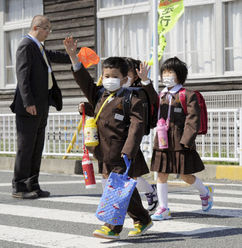 The government's nuclear safety agency on Monday endorsed a report by Tokyo Electric Power Co. estimating radioactive substances 20,000 times the allowable annual limit were carried into the Pacific Ocean by contaminated water leaking from the crisis-hit Fukushima Daiichi nuclear plant in early April. The Nuclear and Industrial Safety Agency approved the report submitted by the plant operator last Thursday and said the leak would not cause immediate health hazards because radioactive materials would be diluted in seawater, while fishing had been banned in areas close to the atomic power station. Hidehiko Nishiyama, a spokesman for the nuclear agency, said the concentration of radioactive substances believed to have leaked into the sea from a cracked pit between April 1 and 6 was about 30,000 times higher than the level seen in low-level radioactive water TEPCO deliberately dumped into the sea between April 4 and 10. |
|
|
April 25, 2011 The operator of the troubled Fukushima Daiichi nuclear power plant is carefully monitoring the situation at the Number 4 spent fuel pool, where the water temperature is rising despite increased injections of cooling water. Tokyo Electric Power Company, or TEPCO, says it will inject 210 tons of water into the pool on Monday, after finding on Sunday evening that the temperature in the pool had risen to 81 degrees Celsius. The utility firm had earlier limited the amount of water being injected into the pool to 70 tons a day, saying the weight of the water could weaken the reactor building, which was already damaged in last month's hydrogen explosion. On Friday, TEPCO found that the pool's temperature had reached 91 degrees, so it began injecting 2 to 3 times the amount of water. TEPCO says the pool's water temperature dropped to 66 degrees on Saturday after water was injected, but started to rise again, to 81 degrees. The operator says the water level in the pool was 2.5 meters lower than normal after 165 tons of water were injected on Sunday. It is carefully monitoring the water level and temperature to avoid further troubles. The Number 4 spent fuel pool stores 1,535 fuel rods, the most at the nuclear complex. NHK NEWS - Monday, April 25, 2011 12:04 |
|
|
April 26, 2011 April 26 news bits of truth... Notice when WE start discussing R4... Tepco "leaks" (pun intended) some type of info on it... High concentration of radioactive water found in Fukushima's No. 4 reactor IIRC, the tunnel height is approx 15 feet. [A concentration of radioactive water in the basement of the No. 4 reactor's turbine building at the crippled Fukushima No. 1 Nuclear Power Plant became abnormally high, reaching a maximum of 250 times normal monthly levels, according to Tokyo Electric Power Co. (TEPCO) on April 26. The utility found that the samples contained 8,100 becquerels of cesium-137 (half-life about 30 years) and 7,800 becquerels of cesium-134 (half-life about 2 years), up about 250 times from the previous survey on March 24. Also found in the fresh samples were 4,300 becquerels of iodine-131 (half-life about 8 days), about 12 times higher than the March probe. The depth of water as of 7 a.m. on April 26 stood at 1.15 meters, up
25 centimeters from April 13.
And this bit of data, confirmed what we've thought all along... The turbine buildings of the No. 3 and 4 reactors are connected
through an electric product room, where power panels and other equipment
are located, leading TEPCO officials to speculate that water being pumped
into the No. 3 unit is believed to be leaking into the No. 4 unit through
a cable gap and other reasons.
~ SOURCE
ETA: So, even though TEPCO has been mum on R4...that pesky reactor just won't cooperate.. Des |
|
|
Apr 26, 2011 More ripples, and "you'll have to pry it from my cold dead fingers..."attitude from TEPCO pres. TEPCO president to resign over scandal English.news.cn 2011-04-26 12:33:20 BEIJING, April 26 (Xinhuanet) -- TEPCO's President has hinted that he will resign in order to take responsibility for the Fukushima disaster, but an exact timeline has not been decided. TEPCO President Masataka Shimizu was grilled by minority party lawmakers in a debate dedicated to the response to the nuclear crisis. TEPCO has been accused of downplaying the dangers and ignoring warnings about the risk of a quake and tsunami striking the plant, as well as reacting poorly to the disaster. When asked whether he planned on resigning, Shimizu confirmed he would be stepping down. Masataka Shimizu,President,Tokyo Electric Power Company(TEPCO), said, "In terms of taking responsibility, I do believe there should be some sort of punishment. However, we are still in the midst of trying to deal with the current situation and there are quite a few obstacles still ahead. As such, I am still unsure of when this would happen." Source: CNTV.cn
Des |
|
|
Apr 26, 2011 Very honest take on TEPCO lying, and things are much worse than is
being told. Says, Japan is at great risk.
Professor Christopher Busby: Can't seal Fukushima like Chernobyl - it all goes into sea. Professor Christopher Busby, the Scientific Secretary of the European Committee on Radiation Risks, believes that the Japanese have been very lax in the way they evacuated people from the exclusion zone. He thinks that the zone should be expanded to a 60-70km radius. Busby thinks that if a sarcophagus is put over Fukushima-1, the nuclear fuel might go underground and get washed away by the sea. The US has already started picking up contaminated material with high concentrations of uranium and plutonium washed up on its coastline, he says. Christopher Busby also thinks that TEPCO has concealed the fact that one of the explosions at Fukushima was not a gas blast, but a nuclear reaction. “The nuclear industry has a history of duplicity and cover-up. I believe
it probably was a nuclear explosion, not in the reactor, but in the tanks
that contains the spent fuel. It seems almost certain now that there was
some kind of nuclear explosion in the tank that contained the plutonium
fuel rods. Anyone who saw that enormous explosion on the video would not
have believed that it was a hydrogen explosion,” says Busby.
ps, if some kind soul could embed this vid, would be of great help TIA. Des |
|
|
Apr 26, 2011 reply to post
by Destinyone Radiation Expert: “Sr-90 and Uranium and Particulates Will
Be Building Up in the USA and Europe … Professor Busby: I attach my “don’t panic” paper. However, since then I have re-thought this advice as the thing is still fissioning and releasing 10 to the fourteen becquerels a day. This will mean that Sr-90 [strontium 90] and Uranium and particulates will be building up in the USA and Europe. I will assess this later but for now I think it prudent to stop drinking milk. I also attach the particulates note.[/ex] Meanwhile, in the good ole U.S. of A.: Someone needs to nudge the needle (kick some butt) at the EPA monitoring. They are stuck on rinse and repeat. No mention of the plutonium and the other iums being detected. Their complicity needs remembering in the times to come. Useless (non)data posted below. April 25, 2011 As of 9:00 am (EDT) EPA's RadNet radiation air monitors across the U.S. show typical fluctuations in background radiation levels. The levels detected are far below levels of concern. Today, EPA also released new data for precipitation and milk. Results for precipitation have detected low levels of radioactive material consistent with estimated releases from the damaged nuclear reactors. These detections were expected and the levels detected are far below levels of public-health concern. To view the most recent sampling and monitoring data, go to Sampling Data April 22, 2011 As of 9:00 am (EDT) EPA's RadNet radiation air monitors across the U.S. show typical fluctuations in background radiation levels. The levels detected are far below levels of concern. Today, EPA also released new data for drinking water, precipitation and milk. Results for precipitation and drinking water have detected low levels of radioactive material consistent with estimated releases from the damaged nuclear reactors. These detections were expected and the levels detected are far below levels of public-health concern. To view the most recent sampling and monitoring data, go to Sampling Data April 21, 2011 As of 9:00 am (EDT) EPA's RadNet radiation air monitors across the U.S.
show typical fluctuations in background radiation levels. The levels detected
are far below levels of concern. ~ Useless link to
the EPA
|
|
|
April 26, 2011 Greetings:
April 6th, 2011 Confidential U.S. document reveals “new threats” at Fukushima:
U.S. Sees Array of New Threats at Japan’s Nuclear Plant United States government engineers sent to help with the crisis in Japan are warning that the troubled nuclear plant there is facing a wide array of fresh threats that could persist indefinitely, and that in some cases are expected to increase as a result of the very measures being taken to keep the plant stable, according to a confidential assessment [dated March 26] prepared by the Nuclear Regulatory Commission. The Times’ article spotlighted several items of extreme importance: • “Semimolten” fuel rods and salt are “impeding the flow of fresh water meant to cool the nuclear cores” in ALL THREE REACTORS • The water flow in reactor No. 1 “is severely restricted and likely blocked“ • Similar problems exist in No. 2 and No. 3, although the blockage is probably less severe • “There is likely no water level” inside the core of reactor No. 1 • There is a possibility of “explosions inside the containment structures”
|
|
|
April 26, 2011 Japan farmers rally against nuclear plant company Some 350 people, mainly farmers from the region around the radiation-leaking Fukushima Daiichi power plant, flocked to the heavily-guarded headquarters of embattled utility Tokyo Electric Power Co (TEPCO) in the capital. Chanting anti-nuclear slogans, they waved in the air cabbages and spinach that had not been sold due to fears of radioactive contamination from the plant, which was hit by a powerful earthquake and tsunami on March 11. They also brought two live milk cows on pick-up trucks, as well as milk in aluminum containers, from their dairy farms near the plant, which is some 250 kilometres (155 miles) north of Tokyo. "TEPCO must stop the radiation leak! TEPCO must pay compensation! TEPCO must give us our hometown back!" demonstrators yelled in unison. Fukushima farmers protest near TEPCO headquarters Farmers affected by the accident at the Fukushima Daiichi nuclear power plant have demanded that its operator put it under control and compensate them as soon as possible. About 200 vegetable and dairy farmers from Fukushima, Chiba, Ibaraki and other prefectures took part in the protest in front of the headquarters of the Tokyo Electric Power Company, or TEPCO, in Tokyo on Tuesday. The farmers displayed vegetables and milk cows, shipments of which have been banned due to radiation concerns, and demanded sufficient compensation for damage caused by the bans and rumors. TEPCO officials apologized to the farmers for causing trouble, saying the firm is trying to settle the crisis and will compensate them with help from the government. Milk shipments from 2 municipalities in Fukushima Prefecture remain banned, as are shipments of spinach, cabbage and other leafy vegetables from the entire prefecture. In a related move, farmers in Chiba Prefecture, east of Tokyo, say the accident has so far cost them 530-million yen, or about 6.5-million dollars. The estimate was reported by a task force set up by agricultural cooperatives in the prefecture at an inaugural meeting on Tuesday. The loss is attributed to bans on shipments of 6 kinds of vegetables from part of the prefecture between April 4th and 22nd, consumer reluctance to buy vegetables from Chiba, and a fall in prices. The farmers plan to seek compensation from TEPCO. |
|
|
April 26, 2011 Here we see a repeat of what ATS members have been saying all along: Chernobyl recovery officer criticises Japan's efforts at Fukushima
Gen Antoshkin said he thought the Japanese were simply unable to cope on their own Photo: AP
Soviet efforts to contain the Chernobyl nuclear disaster a quarter of a century ago were far better than Japan's "slow-motion" response to the disaster at Fukushima, a leading member of the 1986 recovery effort said. In a rare interview on the eve of the 25th anniversary of Chernobyl on Monday, Col-Gen Nikolai Antoshkin said he was shocked at how poorly Japan had coped with its own nuclear disaster. "Right at the start when there was not yet a big leak of radiation they (the Japanese) wasted time. And then they acted in slow-motion," he said. The Soviets had evacuated 44,600 people within two and a half hours and put them up in "normal comfortable conditions" on the same day, he recalled. "Look at advanced Japan," he said. "People are housed in stadiums and are lying about on the floors of sports halls in unhygienic conditions."
|
|
|
Apr 28, 2011 Image of rods in Spent Fuel Pool #4
Reactors: background The Fukushima Daiichi reactors are GE boiling water reactors (BWR) of an early (1960s) design supplied by GE and Toshiba, with what is known as a Mark I containment. Reactors 1-3 came into commercial operation 1971-75. Reactor power is 460 MWe for unit 1, 784 MWe for units 2-5, and 1100 MWe for unit 6. The fuel assemblies are about 4 m long, and there are 400 in unit 1, 548 in units 2-5, and 764 in unit 6. Each assembly has 60 fuel rods containing the uranium oxide fuel within zirconium alloy cladding. Unit 3 has a partial core of mixed-oxide (MOX) fuel (32 MOX assemblies, 516 LEU). They all operate normally at 286°C at core outlet under a pressure of 6930 kPa and with 115-130 kPa pressure in dry containment. NISA says maximum design base pressure for reactor pressure vessels (RPV) is 8240 kPa at 300°C, and for containment (PCV) is about 500 kPa*. At low containment pressures hydrogen and other gases are routinely vented through charcoal filters which trap most radionuclides. Fuel Ponds: background At the time of the accident, in addition to a large number of used fuel assemblies, unit 4's pond also held a full core load of 548 fuel assemblies while the reactor was undergoing maintenance, these having been removed at the end of November. The temperature of these ponds is normally low, around 30°C when circulation is maintained with the Fuel Pool Circulation and Clean-up (FCP) system, but they are designed to be safe at about 85°C in the absence of pumped circulation (and presumably with moderate fuel load). They are about 12 metres deep, so the fuel is normally covered by 7 metres of water. Unit 2, 3 & 4 ponds are about 12 x 10 metres, with 1240, 1220 and 1590 assemblies capacity respectively (unit 1 is about 12 x 7 m, 900 assemblies). Unit 4 pond contains a total 1331 used assemblies (783 plus full fuel load of 548), giving it a heat load of about 3 MW thermal, according to France's IRSN, which in that case could lead to 115 cubic metres of water boiling off per day, or about one tenth of its volume. Unit 3's pool contains 514 fuel assemblies, unit 1 has 292 and unit 2 has 587, giving it a heat load of 1 MW. There is no MOX fuel in any of the ponds. Two of the reactor unit ponds (2 & 4) were unusually full before unit 4 core was unloaded in November, since there was little spare space (only for 465 assemblies) in the central fuel storage pond on site. Thus there was a lot more fuel in the reactor ponds with correspondingly high heat loads and cooling requirements than might have been the case. Moving the used fuel from reactor ponds to central storage involves loading it under water into casks which are lowered down and trucked the short distance (see RH side of cutaway diagram above). It requires access from the service floor and the use of cranes which were damaged in the hydrogen explosions. The central fuel storage on site near unit 4 has a pond about 12 x 29 metres, 11 m deep, with capacity of 3828 m3 and able to hold 6840 fuel assemblies. Its building is about 55 x 73 m. (There are 6375 assemblies in the undamaged central pool storage on site, with very low decay heat, and 408 in dry cask storage - utilized since 1995 for used fuel no longer needing much cooling.) World Nuclear Organization: Fukushima Accident Details. I highly recommend taking the time to view this video dated April 22. It is the most extensive footage I have seen from the grounds and control room at Fukushima. We need a save and preserve mission on this a.s.a.p. And translations... Youtube Link (dead Video now) Can someone download and save this video? I have my doubts as to how long it will remain available. Thanks in advance. |
|
|
April 29, 2011 This is no conspiracy, the Japanese are actively and openly trying to censor media (and other sources): The Japanese government has moved to crack down on independent reportage and criticism of the government’s policies in the wake of the disaster by deciding what citizens may or may not talk about in public. A new project team has been created by the Ministry of Internal Affairs and Communication, the National Police Agency, and METI to combat “rumors” deemed harmful to Japanese security in the wake of the Fukushima disaster. The government charges that the damage caused by earthquakes and by the nuclear accident are being magnified by irresponsible rumors, and the government must take action for the sake of the public good. The project team has begun to send “letters of request” to such
organizations as telephone companies, internet providers, cable television
stations, and others, demanding that they “take adequate measures based
on the guidelines in response to illegal information. ”The measures include
erasing any information from internet sites that the authorities deem harmful
to public order and morality.
Japan Focus Letter of Request Via google translation - the original japanese letter can be found on the METI site (A genuine Japanese translation would be appreciated!) False rumors to incite public unrest prank, circulated by the light of the circumstances to write to the bulletin boards, etc., concerned about false rumors on the Internet. agencies work together for the site administrator, etc., including information voluntarily remove obscene laws and requested to take appropriate action and make efforts so that accurate information is provided to users With co-operation of the Japanese media:
About METI... NISA - the Japanese safety watchdog - was established as a special entity of the METI Prime Minister Naoto Kan is looking into the feasibility of separating
the Nuclear and Industrial Safety Agency from the Ministry of Economy,
Trade and Industry, according to government sources. ~ Japan Times - [dead link] METI (Japanese Ministry of the Economy, Trade and Industry) have big
plans for nuclear energy:
May 05, 2003 This summer, the Japanese Ministry of the Economy, Trade and Industry (METI) will issue a ten-year energy plan prepared cooperatively with the Japanese Federation of Electric Power Companies (FEPC). The document will include measures for reducing Japan's reliance on Middle Easter oil and facilitating new reactor projects. ~ Aveva This news is about a week old but I missed it first time round. |
|
|
April 29, 2011 Originally posted by Moonbeams771 Someone doesn't want the Japanese people to make their own decisions: Weather chief draws flak over plea not to release radiation forecasts The chief of the Meteorological Society of Japan has drawn flak from within the academic society over a request for member specialists to [b]refrain from releasing forecasts on the spread of radioactive substances from the troubled Fukushima Daiichi nuclear plant. In the request posted March 18 on the society's website, Hiroshi Niino, professor at the University of Tokyo, said such forecasts, which he says carry some uncertainty, ''could jumble up information about the government's antidisaster countermeasures unnecessarily.'' ''The basic principle behind antidisaster measures is to enable people to act on unified reliable information,'' he said. The problem is that no one is providing any reliable information. |
|
|
April 29, 2011 TOKYO—A prominent Japanese radiation safety specialist has resigned his governmental advisory post in protest over what he calls "inexcusable" standards for school children in Fukushima Prefecture. The Yomiuri Online news web site reported in Japanese this evening that Toshiso Kosako, a radiation safety expert at the University of Tokyo, feels the standards are too lenient and that his advice has been ignored. On 19 April, the ministry of education announced a "provisional idea" for schoolyards contaminated by radiation emanating from the ravaged Fukushima Daiichi Nuclear Power Plant. The ministry cited a recommendation by the International Commission on Radiological Protection (ICRP), based in Ottawa, Canada, that sets an acceptable level of between 1 and 20 millisieverts (mSv) per year for individuals. In its Application of the Commission's Recommendations to the Protection of People Living in Long-term Contaminated Areas After a Nuclear Accident or a Radiation Emergency , ICRP recommendation reads: The reference level for the optimization of protection of people living in contaminated areas should be selected in the lower part of the 1-20 mSv/year band. Japan's education ministry figured that children could spend 8 hours a day in a schoolyard with as much as 3.8 microsieverts per hour of radiation and then 16 hours a day inside a building with 1.52 microsieverts per hour and stay within a 20 mSv per year limit. Some 800 groups and 34,000 individuals have signed a petition demanding the withdrawal of the education ministry's 20 mSv per year standard, according to a coalition of citizens' organizations that will present the petition to the government on 2 May. "Setting this (radiation exposure) number for elementary schools is
inexcusable," says Kosako, according to Yomiuri Online. His resignation
is expected to put additional pressure on the government to rethink its
decision.
SOURCE |
|
|
May 03, 2011 Update for the Greenpeace testing: We have finally reached the Fukushima coast to begin our research.
The limitations set by the government mean we can only conduct a fraction
of what we came here to do, and only outside Japan’s 12-mile territorial
waters, but we are doing everything we can.
Greenpeace speak a lot of sense:
Many
governments try to silence their critics, but our mission
is not to criticise the government. The Rainbow Warrior is here off the
coast of Japan to carry out essential, independent radiation testing,
and
to share this information with the authorities and the people of Japan.
We have been, and will continue providing transparent information that
will help people to protect both their health and livelihoods. The
Japanese Government has nothing to lose by allowing independent
research by NGOs like Greenpeace. If it wants to avoid harmful rumours
then more - not less - research is absolutely crucial. We hope that the
government will stop playing politics, reverse its
decision to block our research, and allow us to do what we came here to
do: provide clear, independent information to the people for whom help
is needed.
Greenpeace Rainbow Warrior begins sampling off Fukushima |
|
| May 04, 2011 Gov't assumed worst-case scenario at Fukushima nuclear plant Wednesday 04th May, 06:17 AM JST TOKYO — The government assumed a worst-case scenario of ‘‘significant public exposure’’ to radiation when workers were struggling to bring a nuclear reactor under control at the Fukushima Daiichi power plant a day after the March 11 earthquake and tsunami, Kyodo News learned Tuesday. The scenario assumed the container of the No. 1 reactor would be damaged and people around the plant would be exposed to several sieverts of radiation, a potentially lethal level, if the workers failed to reduce pressure within the containment vessel by venting steam, according to sources in the government and the plant operator as well as documents. © 2011 Kyodo News. |
|
|
May 04, 2011 Originally posted by jjjtir Seabed radiation 100-1,000 times normal level off Fukushima plant
Radiation readings have risen to 100-1,000 times the normal level on the Pacific seabed near the crippled Fukushima Daiichi nuclear power plant, the operator said Tuesday. ~ TOKYO, May 3, Kyodo News Full article now on Mainichi News: 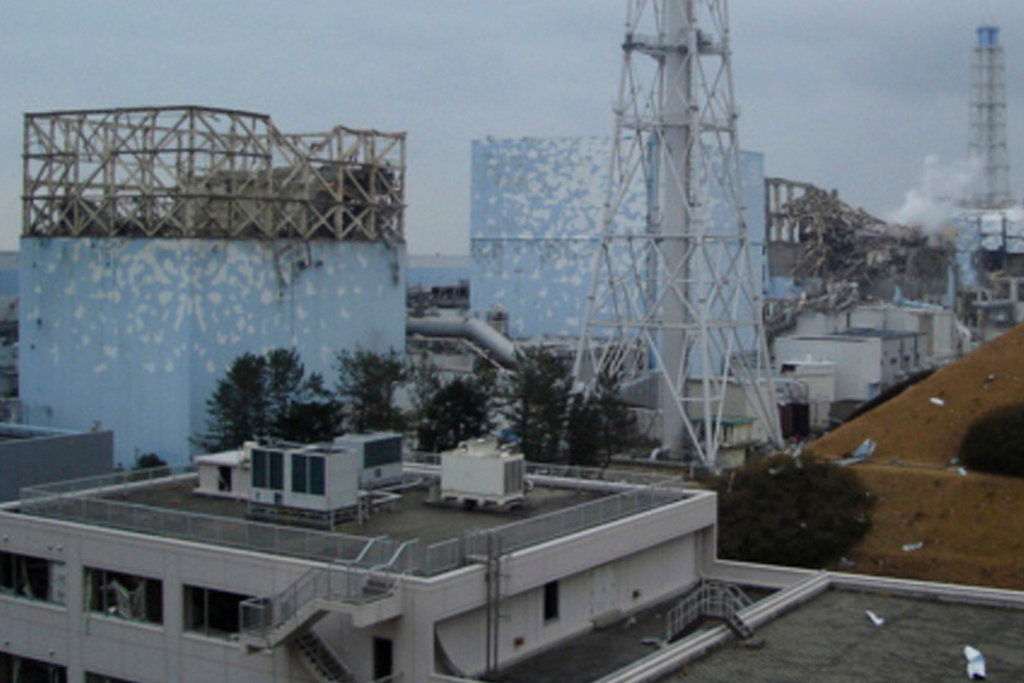 A photograph shows Tokyo Electric Power Co. (TEPCO)'s Fukushima No. 1 nuclear power plant on March 15. From left, the No. 1, 2, 3 and 4 reactors. (Photo courtesy of TEPCO) TOKYO (Kyodo) -- Radiation readings have risen to 100-1,000 times the normal level on the Pacific seabed near the crippled Fukushima Daiichi nuclear power plant, the operator said Tuesday. The high levels of radioactive materials were detected in samples collected Friday from the seabed at two points 20-30 meters deep in the first contamination probe of the seabed by Tokyo Electric Power Co., it said. The seabed samples collected 3 kilometers from Minamisoma and 3 km from Naraha, both in Fukushima Prefecture, contained 98-190 becquerels of radioactive iodine per kilogram and 1,200-1,400 becquerels of radioactive cesium. The normal readings for the materials can be up to several becquerels, the utility said. TEPCO said it believes the radioactive substances may have fallen into the sea after being released into the air from the plant or may have been carried by contaminated water that seeped from the plant. 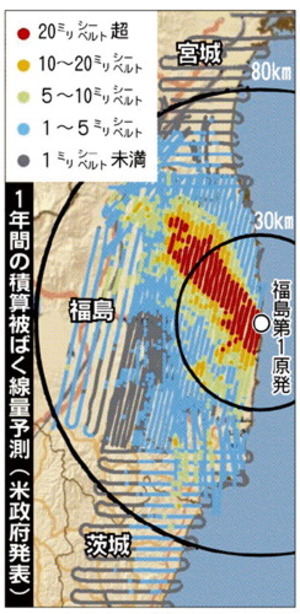 The NNSA hazard map released by the U.S. federal government. The Fukushima No. 1 Nuclear Power Plant is marked by a white dot at right. Meanwhile, the science ministry said it had not detected radioactive substances in samples collected Friday from the seabed at a depth of 117 meters at a point 10 km from a spot on the coast 50 km south of the Fukushima plant. Mainichi News Japan May 4, 2011 |
|
| May 04, 2011 Originally posted by DancedWithWolves I'm sorry but this is just man(woman)slaughter. This building is where some workers have been sleeping on floors and are spending most of their time when not out on the grounds. This building was "the shelter" and is was not being checked for radiation levels? Lies, lies, lies and willfully putting workers in harms way.Someone checked the levels and didn't reveal the data to the workers. If these two women were exposed - they all have been exposed to these levels and beyond inside their own designated safe building. TEPCO neglected radiation checks in building where two women absorbed high doses Tokyo
Electric Power Co. (TEPCO) failed to check the levels of radiation
inside a key operation center at the crippled Fukushima nuclear power
plant before two female workers were exposed to high levels of
radiation there.
The two workers have recently been exposed to radiation higher than the legal limit for female workers -- lower than that for men -- of 5 millisieverts over a three-month period. For about two weeks after the March 11 earthquake, the utility did not check the radiation levels inside a special quake-resistant building where the two workers were exposed. About 200 workers use the building on the premises of the Fukushima No. 1 Nuclear Power Plant each day as a base to deal with the ongoing crisis. The building was opened for use in July 2010 as an emergency response base. Located about 200 meters northwest of the No. 1 nuclear reactor, it was built to withstand earthquakes measuring the strongest quakes on the Japanese seven-point scale. However, its structure allows small amounts of radiation to leak through vents. When designing the power plant, the utility had not envisaged the hydrogen explosion that actually damaged the doors of the building and permitted radioactive substances to flow in inside. TEPCO said the delay in preparing a "buffer area" where workers were supposed to take off their protective gear was a factor behind its failure to prevent radioactive substances from coming into the building. One of the women in her 50s suffered internal radiation exposure of 13.6 millisieverts (and external exposure of 3.95 millisieverts), while another woman in her 40s had internal exposure of 6.71 millisieverts (and external exposure of 0.78 millisieverts) -- numbers which suggest most of their exposure came from what they inhaled in the building. TEPCO said it had been aware that the levels of radiation inside the building were high. But it then said, "We initially thought that way because the levels of radiation outside the building were high." TEPCO started checking the levels of radiation in the building on March 24 -- a day after it stopped female workers from working there. Since then, TEPCO has taken steps such as setting up small rooms equipped with air cleaners at entrances and putting lead sheets over the windows to shut out radiation. TEPCO has also been checking male workers on their internal radiation exposure. Male workers are allowed to be exposed to up to 250 millisieverts of radiation per year. "We should've had workers wear masks earlier. I believe the fact that radioactive substances entered the building after the hydrogen explosion will be an important lesson for us. We want to assess the way TEPCO handled the situation as quickly as possible," said Hidehiko Nishiyama, a spokesman for the Nuclear and Industrial Safety Agency. |
|
|
April 04, 2011 Japanese graffiti artist adds Fukushima disaster to famous
A-bomb mural
One of the most famous pieces of art in Tokyo is "Myth of Tomorrow," a mural by Picasso-influenced artist Taro Okamoto, depicting the horrors of the atomic bomb. Over the weekend, someone added a new panel to the mural. The new addition depicts the towers of Fukushima Daiichi Nuclear Power Plant melting down. And whoever did it, they managed to copy the style of the original mural pretty closely. The new panel was on display for a few hours, before the police took it down — it caused no damage to the original mural, just added to it. |
|
|
May 04, 2011 A 30 minute documentary looking inside the lives of exploited workers in Japan's nuclear industry. Subtitled in English. FILM: Nuclear Ginza (1995) Röhl, Nicholas. 1995. Kakusareta Hibaku Rōdō: Nihon no Genpatsu Rōdōsha.
隠された被曝労働 – 日本の原発労働者 物語 [Nuclear Ginza]
- YouTube video Nicholas Röhl, a student of Japan’s master director Imamura Shohei,
produced this 30-minute documentary in 1995 for Channel 4. The film
exposes how Japan’s nuclear energy industry used disadvantaged people
in the 1970s and ’80s to carry out highly dangerous manual labor inside
their power stations. The story follows the photojournalist/ anti-nuclear
activist Kenji Higuchi as he exposes the exploitation of the “untouchables”
who were pulled out of the slums of Tokyo and Osaka in order to work while
exposed to radiation, often without their knowledge. Referring to the tacit
cooperation and close ties between the Japanese government and the country’s
nuclear industry, a man notes in one scene that “democracy has been destroyed
where nuclear power stations exist.” The film shows how Japan, having
suffered nuclear attacks in the past, remarkably transformed itself within
a few decades into one of the most “nuclearized” nations worldwide.
This documentary film has special significance in the light of the recent
Fukushima nuclear crisis, in which media reports about the exploitation
of unskilled laborers in the plant spawned a major controversy.
– Christian Dimmer Documentary "Nuclear Ginza" - Part 1 - Youtube VideoDocumentary "Nuclear Ginza" - Part 2 - Youtube Video |
|
|
May 04, 2011 Greetings Fellow collective brain cells... I've been only reading for a bit the past week, busy IRL. Great work done here. Kudos to all keeping a candle in the window. At least there are kindred minds still bubbling to the surface. Japan’s Fukushima Power Station Now Beyond Anyone’s Ability
To Control
In an attempt to preserve some credibility for the nuclear power industry, Japanese authorities tried to use reassuring language in their statements, and were hesitant to compare what was going on at Fukushima to Chernobyl.[/ex] Japan is heavily invested in nuclear energy, so it is not surprising that they would want to play down the damage. However, considering the danger this situation poses to the Japanese people, and those in the region, the Japanese government had a duty to be honest about the seriousness of this situation. Considering a 2005 report, from the National Academies of Science, that any level of radiation, however small, can cause cancer, Japan’s situation is now considered deadly and will be for decades. The Japanese people have displayed incredible courage, order and decorum in the face of unmitigated disaster. Journalists, volunteers and aid workers from around the world have gone beyond the call of duty to extend help to the hardest hit zones, but this crisis is now beyond anyone’s ability to control. Good to be back..... Des |
|
|
May 04, 2011 Man I think that art is cool and pretty well rendered in the other fellows style they should leave it , perhaps the government of Japan can use it as a symbol of their attempt at re-humanizing themselves. Of course that may not be possible they seem a little confused at the root of things as I was trying to discover the mysterious METI codes on the tepco warning/error codes ( from the reactor data gauges ) I figured that the Ministry of Economic Trade an Industry or METI website would, logically, have the decoder ring for such posted as a public service on standards and measure and such, and they do have a section listed as "Nuclear and Industrial Safety Agency" And first on it at #149 on Meti's list, sure enough is " Act on the Regulation of Nuclear Source Material, Nuclear Fuel Material and Reactors which seems to be concise enough. Unfortunately when you click the link you see:
ah, now this seems to be the stuff , eh ? special measure on preparedness,surely some though provoking and re-assuring information and illumination will be found here... but when you follow the link:
hhhmmmm?, I guess this explains the problem they cannot fix the reactors because the special preparedness for Emergencies accidentally is confusing nuclear reactors with integrated circuit design from 1985, a perfectly reasonable mistake , I can see how the two have the same level of hazard status , I mean a bad circuit design could cause the brakes to fail on that reactor , or leave unsigned code in the security hash and allow it's root to be hacked and then where would we be , eh? that's some fine out of the box thinking there . Who needs giant robots, food or clean air when we have emergency preparation of this clarity and analytical prowess? |
|
|
May 04, 2011 Surprise surprise...not.
Japan Kept Secret on Fukushima Radiation Measurements
World | May 3, 2011, Tuesday The Japanese government admitted it kept in secret at least 5000 radiation radiation measurements and assessments after the nuclear event which struck the Fukushima Daiichi NPP in March. This was done in order not to induce panic in the population, a representative of the staff dealing with the nuclear emergency told ITAR-TASS. "It was a wrong decision," he admitted, pointing out that all upcoming information abouth Fukushima Daiichi will be spread immediately. The system which collects data about radiation leaks from the Japanese
nuclear power plants does not work effectively, Japanese media have reported,
according to the Russian agency.
|
|
| May 06, 2011 Originally posted by Destinyone PM Kan orders halt of ALL operations at another N plant in Japan.
Concerned over risk to public.
Japan PM to ask Chubu to halt all ops at Hamaoka nuclear plant
TOKYO May 6 (Reuters) - Japanese Prime Minister Naoto Kan said on Friday
he will ask Chubu Electric Power Co to halt all operations at its Hamaoka
nuclear plant in central Japan. Older photo of Chuba Facility here... What does Kan know, that we don't know. Everything I've found on this subject, it might even be for political reasons, to offset TEPCO'S losses in some insane balance sheet in Kan's mind. Here is much more on the decision by Kan to halt ALL operations at Chuba N plant. Des |
|
|
May 06, 2011 Kan calls for halt of Hamaoka nuclear plant Prime Minister Naoto Kan has asked a utility firm in central Japan to halt operations of all active reactors at the Hamaoka nuclear power plant, due to the risk of earthquakes. Kan told a hastily arranged news conference on Friday evening that he made the decision in the wake of the accident at the Fukushima Daiichi nuclear plant. The prime minister said he asked Chubu Electric Power Company that operates the Hamaoka plant to halt reactors No.4 and No.5, and not to restart reactor No.3, which is now offline for regular inspections. The plant in Shizuoka Prefecture has 5 reactors, but units No.1 and 2 are permanently shut down for decommissioning. The Hamaoka complex is known to sit directly above the projected focus of the Tokai Earthquake that experts have long warned of. Kan said that a science ministry panel on earthquake research has projected an 87-percent possibility of a magnitude-8-class earthquake hitting the region within 30 years. He said that considering the unique location of the Hamaoka plant, the operator must draw up and implement mid-to-long-term plans to ensure the reactors can withstand the projected Tokai Earthquake. Kan also said that until such plans are implemented, all the reactors should remain out of operation. Chubu Electric has declined to respond immediately to the prime minister's request. But Kan said he will try hard to win the company's understanding. The prime minister added that his government will do its utmost to ensure the stoppage of the reactors does not seriously affect power supplies in Chubu Electric's service areas. Kan said that although power shortages might occur when demand surges in the summer, he is confident that with the cooperation and understanding of the public, the nation can overcome such difficulties. NHK News - Friday, May 06, 2011 21:02Hamaoka plant sits in Tokai quake focal zone The Hamaoka nuclear power plant is located above the projected focus of a magnitude-8-class earthquake that could strike Shizuoka Prefecture. Seismologists have long been warning that the likely Tokai earthquake could occur any time. They say massive earthquakes have hit the region every 100 to 150 years, but no major quake has occurred there since the one that struck in the 19th century. The government predicts that the focus would stretch inland from the southern edge of Yamanashi Prefecture to the central and western parts of Shizuoka Prefecture, and to the prefecture's Pacific coastal area as well. All areas in Shizuoka would feel a jolt with an intensity of 6-minus to the maximum 7 on the Japanese scale of 0 to 7. It also projects that a major tsunami of more than 5 meters will strike the coastal area and in some places, the waves could top 10 meters. |
|
| FAIR USE NOTICE: This page contains copyrighted material the use of which has not been specifically authorized by the copyright owner. Pegasus Research Consortium distributes this material without profit to those who have expressed a prior interest in receiving the included information for research and educational purposes. We believe this constitutes a fair use of any such copyrighted material as provided for in 17 U.S.C § 107. If you wish to use copyrighted material from this site for purposes of your own that go beyond fair use, you must obtain permission from the copyright owner. | |
|
|
